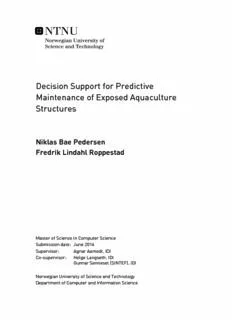
Decision Support for Predictive Maintenance of Exposed Aquaculture Structures PDF
Preview Decision Support for Predictive Maintenance of Exposed Aquaculture Structures
Decision Support for Predictive Maintenance of Exposed Aquaculture Structures Niklas Bae Pedersen Fredrik Lindahl Roppestad Master of Science in Computer Science Submission date: June 2016 Supervisor: Agnar Aamodt, IDI Co-supervisor: Helge Langseth, IDI Gunnar Senneset (SINTEF), IDI Norwegian University of Science and Technology Department of Computer and Information Science i Problem Description In cooperation with SINTEF Fisheries and Aquaculture, our project is within EXPOSED SFI. We are under the technical Area 2 - Moni- toringandoperationaldecisionsupport. Ourmaintaskistostudythe combined use of data-driven machine learning (ML) and case-based reasoning (CBR) for enhanced data analysis and active decision sup- port in fish farming, especially for the production structures. In the specialisation project Decision Support System for Exposed Aquaculture Operations, there was proposed an architecture for a de- cision support system for predictive maintenance of exposed aquacul- ture structures. In this MSc thesis, the task is to study the method of implementing a system based on this architecture. To achieve this goal, a new data analysis must be done. This analysis consists of pre-processing and exploratory analysis, as well as modelling and machine learning. As the previously proposed archi- tecture is based on some assumptions and sensors not available in this MSc thesis, it is expected that revising the architecture is needed. The architecture is based on principles from Structural Health Monitoring, Case-Based Reasoning and Machine Learning. The de- velopment of a prototype system consist of creating the different el- ements that constitutes the system, as well as implementation and evaluation. ii iii Abstract It is a global challenge to produce enough healthy food to a growing world population. By moving industrial fish farming to exposed lo- cations, the farmers can possibly satisfy the dietary requirements of the future by expanding the production. The environment at exposed locations is rough, and conditions like harsh wind, large waves and strong currents are present. On the positive side, there are better wa- ter flow and distribution of waste. Exposed locations are also further awayfromnaturalsalmons, whichmightreducenegativeenvironmen- tal effects. The production plants for fish farming are designed to be flexible and adaptive to waves and sea currents. Monitoring of the health and conditionofthesestructureswillbemoreimportantregardedreducing cost of operations and maintenance. This data can be combined with historicaldataandexpertknowledgetosupporttheoperatorsdecision about acting upon a possible problematic situation. Our goal in this MSc thesis is to study the method of implement- ing a decision support system for predictive maintenance of exposed aquaculture structures, based on a previously proposed architecture fromthespecialisationproject. Thearchitectureisbasedonthefields of Machine Learning, Structural Health Monitoring and Case-Based Reasoning. This thesis describes the work done in order to achieve our goals, which includes the work of researching the relevant domains, con- ducting a data analysis, creating models with the resulting data sets, revisingthepreviouslyproposedarchitectureandimplementingapro- totypical decision support system. At last we conclude and discuss the future work. The work with this thesis shows that our prototype of a decision supportsystemisabletosupportanoperatorwithadviceaboutwhat todo, ifasituationsimilartopreviouslyexperiencedsituationsoccur. iv v Sammendrag Det er en global utfordring˚a produsere nok sunn mat til en verdenbe- folkning i vekst. Ved˚a flytte industriell fiskeoppdrett til eksponerte omr˚ader, kan oppdretterne ekspandere produksjonen slik at kravene til fremtidens matmengder blir tilfredsstilt. Ved eksponerte omr˚ader er miljøet tøft, og fohold som kraftig vind, store bølger og sterk strøm kan forekomme. P˚a den positive siden er det bedre vanngjennom- strømning og distribusjon av avfall. Eksponerte omr˚ader er i tillegg lengre unna villaks, hvilket kan redusere sannsynligheten for negative miljøp˚avirkninger. Anleggenebrukttilfiskeoppdretterfleksibleogadaptivetilbølger og havstrømmer. Overv˚aking av disse strukterens helse og tilstand vil bli viktigere med tanke p˚a kostnadene ved operasjoner og vedlike- hold. Kombinert med historisk data og ekspertkunnskap, kan denne dataenstøtteoperatørenesbeslutningern˚arproblematiskesituasjoner oppst˚ar. M˚aletmeddennemasteroppgavener˚astuderemetodenforimple- mentasjon av et beslutningsstøttesystem for prediktivt vedlikehold av eksponerte akvakulturelle strukturer, basert pÃě en tidligere foresl˚att arkitektur fra forprosjektet. Arkitekturen er basert pÃě omr˚adene Machine Learning, Structural Health Monitoring og Case-Based Rea- soning. Oppgaven beskriver arbeidet gjort for˚a n˚a prosjektets m˚al, dette inkluderer forskning av relevante domener, gjennomføring av en data- analyse, utforming av modeller med det resulterende datasettet, rev- idering av den tidligere foresl˚atte arkitekturen og implmentasjon av et prototypisk beslutningsstøttesystem. Til slutt konkluderer vi og diskuterer fremtidig arbeid. Arbeidet med denne oppgaven viser at v˚art prototypiske beslut- ningsstøttesystemerkapabelttilÃěr˚adgioperatøren, dersomensitu- asjon lignende til en tidligere opplevd situasjon skulle oppst˚a. vi vii Preface This MSc thesis is written at the Department of Computer and Infor- mation Science at Norwegian University of Science and Technology, in collaboration with SINTEF Fisheries and Aquaculture. The work started with a specialisation project within the Artificial Intelligence field in autumn 2015. Duringtheproject, thegoalsandspecificationswereredefineddue to the data available. As the data was delivered midway through the projectperiodandwasfoundinsufficientfortheoriginalspecification, we focused more on research within the domain, creating reasonable symptoms and cases, and revising the architecture. The need for an implemented prototype became less important, and we focused more on studying the method. We would like to thank our main supervisor Agnar Aamodt at NTNU for expertise, guidance and discussions throughout the project period. Wewouldalsoliketothankourco-supervisorsHelgeLangseth at NTNU and Gunnar Senneset at SINTEF FH for valuable inputs andfeedback. FurtherwewouldliketothankKerstinBachatNTNU, BjÃÿrn Magnus Mathisen at NTNU/SINTEF, David Kristiansen at SINTEF FH and Martin FÃÿre at SINTEF FH for their contribution. viii
Description: